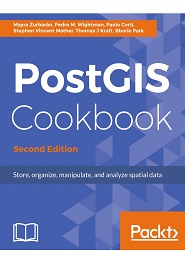
English | 2018 | ISBN: 978-1788299329 | 584 Pages | PDF, EPUB | 63 MB
Create and manage spatial data with PostGIS
PostGIS is a spatial database that integrates the advanced storage and analysis of vector and raster data, and is remarkably flexible and powerful. PostGIS provides support for geographic objects to the PostgreSQL object-relational database and is currently the most popular open source spatial databases.
If you want to explore the complete range of PostGIS techniques and expose related extensions, then this book is for you.
This book is a comprehensive guide to PostGIS tools and concepts which are required to manage, manipulate, and analyze spatial data in PostGIS. It covers key spatial data manipulation tasks, explaining not only how each task is performed, but also why. It provides practical guidance allowing you to safely take advantage of the advanced technology in PostGIS in order to simplify your spatial database administration tasks. Furthermore, you will learn to take advantage of basic and advanced vector, raster, and routing approaches along with the concepts of data maintenance, optimization, and performance, and will help you to integrate these into a large ecosystem of desktop and web tools.
By the end, you will be armed with all the tools and instructions you need to both manage the spatial database system and make better decisions as your project’s requirements evolve.
What You Will Learn
- Import and export geographic data from the PostGIS database using the available tools
- Structure spatial data using the functionality provided by a combination of PostgreSQL and PostGIS
- Work with a set of PostGIS functions to perform basic and advanced vector analyses
- Connect PostGIS with Python
- Learn to use programming frameworks around PostGIS
- Maintain, optimize, and fine-tune spatial data for long-term viability
- Explore the 3D capabilities of PostGIS, including LiDAR point clouds and point clouds derived from Structure from Motion (SfM) techniques
- Distribute 3D models through the Web using the X3D standard
- Use PostGIS to develop powerful GIS web applications using Open Geospatial Consortium web standards
- Master PostGIS Raster
Resolve the captcha to access the links!